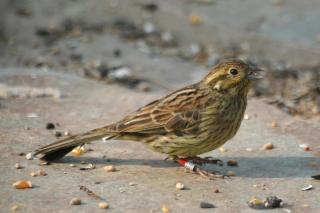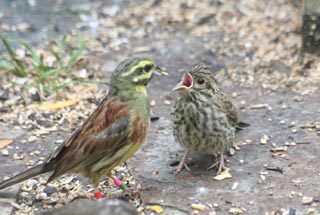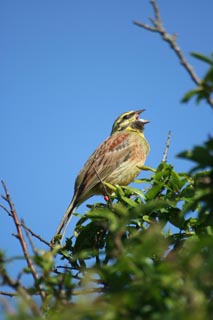 If you’re a Roseland resident and you’ve never heard of a cirl bunting, where have you been? The Cirl Bunting Reintroduction Project, a joint venture between the RSPB, Paignton Zoo, The National Trust and Natural England, has been doing exactly what is says on the tin, and reintroducing cirl buntings to the Roseland since 2006. Despite attempting to keep a low profile to protect the birds from disturbance, the project is possibly the Roseland’s worst kept secret, and I’m sure many of you will know something about what we’re up to!
If you’re a Roseland resident and you’ve never heard of a cirl bunting, where have you been? The Cirl Bunting Reintroduction Project, a joint venture between the RSPB, Paignton Zoo, The National Trust and Natural England, has been doing exactly what is says on the tin, and reintroducing cirl buntings to the Roseland since 2006. Despite attempting to keep a low profile to protect the birds from disturbance, the project is possibly the Roseland’s worst kept secret, and I’m sure many of you will know something about what we’re up to!
The cirl bunting is a small, farmland bird, closely related to a yellowhammer, and about the size of a sparrow. In fact the females could easily be overlooked as a sparrow, but the males have bold yellow and black bands across their heads and an olive green wash on their yellow chests (see photos). In the UK, the species previously lived right across the south of England, up into the Midlands and parts of Wales. But in the latter half of last century the population declined rapidly and by 1989 an RSPB survey revealed just 118 pairs, found only in a narrow coastal strip between Exeter and Plymouth. The decline was associated with changes in farming practice, notably the switch from spring-sown to autumn-sown cereal crops, the removal of hedgerows, and the use of chemicals that killed off their invertebrate prey. In Cornwall, the species would have been present right up to the late-80s, and probably beyond. Some have suggested that cirl buntings are still surviving in isolated pockets in the county, but no evidence of these birds has been found.
The Roseland Peninsula was one of the last remaining locations for breeding cirl buntings outside of Devon, due to its mix of suitable habitats. Although some of this land was safeguarded for farmland birds under Countryside Stewardship, the population was probably too small to be able to sustain itself. Countryside Stewardship was the government’s agri-environmental scheme that provided grants to farmers who managed their land with the environment in mind. In Devon, the RSPB has been working with farmers since the 1989 survey to implement more suitable habitat management, with great success. By 2003, the population had reached 700 pairs – a five-fold increase in just 15 years! Most of this was on land managed under Countryside Stewardship. This has now been replaced by Environmental Stewardship, which should provide the same environmental benefits, but in a more targeted way.
 Despite the population increase, there was not an increased distribution to match it, as the population simply consolidated its existing range. Partly this was down to the blocking effect of Plymouth and Exeter, and due to other developments leaving fragments of suitable habitat. For a bird that moves little more than a kilometre or two from where it was born, range expansion is not a rapid process, especially with little suitable habitat to move into. So the notion of reintroduction was suggested. This would act as a buffer for the species in case anything should happen to the vulnerable Devon population. A release site would need to provide everything a cirl bunting could need: food in summer and winter, and suitable nest sites – what we call the ‘Big Three’ for farmland birds. It would also need to be a place where the birds had been previously, and where they would be able to expand into new areas. Of all the sites scoured by the RSPB’s ‘property’ team, the Roseland came out on top!
Despite the population increase, there was not an increased distribution to match it, as the population simply consolidated its existing range. Partly this was down to the blocking effect of Plymouth and Exeter, and due to other developments leaving fragments of suitable habitat. For a bird that moves little more than a kilometre or two from where it was born, range expansion is not a rapid process, especially with little suitable habitat to move into. So the notion of reintroduction was suggested. This would act as a buffer for the species in case anything should happen to the vulnerable Devon population. A release site would need to provide everything a cirl bunting could need: food in summer and winter, and suitable nest sites – what we call the ‘Big Three’ for farmland birds. It would also need to be a place where the birds had been previously, and where they would be able to expand into new areas. Of all the sites scoured by the RSPB’s ‘property’ team, the Roseland came out on top!
A trial was carried out in Devon in 2004/2005 to test whether the method would be successful, and indeed it was. Consequently, the project began in Cornwall in 2006, with the first translocation. Chicks are removed under license from nests in Devon, and taken to the rearing facilities in Cornwall. Two dedicated aviculturalists from Paignton Zoo spend each day feeding the young birds between 6am and midnight. At first the birds go into brooders, which mimic nests and keep the birds warm and contained. Then they move to canary cages, where they can perch and flap, and develop muscle all the time. Whilst here, they learn to feed for themselves, and are promptly whisked away to the release site, where they spend a further week or so in outdoor aviaries becoming accustomed to their surroundings. This is called a ‘soft release’, as they are able to experience the conditions and learn the sights and sounds of their location before we release them.
 Each bird is given a unique colour combination of leg rings so that we can identify each individual bird. This means that we can assess survival and dispersal by monitoring which birds are seen and where they go. We have also made some interesting findings from this work that would not have been possible without a ringed population. For example, it appears that pairs stay faithful each breeding season, assuming both birds survive the winter. We have also seen that older, more experienced birds are much more successful during the breeding season than the young birds. This is potentially another reason that productivity has been quite low, and hopefully we will begin to see this improve as more birds reach a mature age!
Each bird is given a unique colour combination of leg rings so that we can identify each individual bird. This means that we can assess survival and dispersal by monitoring which birds are seen and where they go. We have also made some interesting findings from this work that would not have been possible without a ringed population. For example, it appears that pairs stay faithful each breeding season, assuming both birds survive the winter. We have also seen that older, more experienced birds are much more successful during the breeding season than the young birds. This is potentially another reason that productivity has been quite low, and hopefully we will begin to see this improve as more birds reach a mature age!
2010 saw a steady, continued rise in the breeding population and thanks to the generally fine summer weather, most pairs pursued two, or even three breeding attempts. The result of all this activity was the production of at least 39 juveniles. Intensive monitoring of these breeding birds again revealed what complex lives they can lead with separations and re-pairings being not uncommon. Also, as in 2009, one particular male, who at over four years old is our oldest surviving bird, paired with just the two different females this year compared to last year’s three! His performance has become legendary in the cirl world and, no doubt, his productivity will be what all others will be compared with for a very long time to come. Long may he continue!
Another very good year of hand rearing saw 70 of the intake of 76 chicks from Devon survive to release. All sporting their assortment of uniquely colour-co-ordinated leg rings, several have already ventured some way beyond their release area to mix with their wild-bred relatives. In an attempt to reduce the impact that sparrowhawks have on the cirl bunting population, a few methods of non-lethal intervention were trialled this year. Central to this was a technique of providing supplementary food, in the form of commercially-reared dead quails, to the local pair of breeding sparrowhawks. Similar methods have been used in similar scenarios with great success, for example with kestrels that jeopardise breeding success at little tern colonies in the east of England. Initial results suggest that this action may have led to increased survivorship within the released population. Continued monitoring from project staff and volunteers will, hopefully, determine if this is indeed the case.
 As the winter progresses it is likely that the cirls will continue to disperse further afield seekingout their favoured foraging habitat of over-wintered, weed-rich stubbles and bird-seed mix crops. Many of these areas have been put in place through the continued support from local farmers. Their continued involvement with the project has safeguarded large areas of farmland habitat for wildlife. Over 700 hectares of land near the release site is now managed under the new Higher Level Stewardship Scheme, where the farmers receive financial support from Natural England for environmentally sensitive practices. This will secure the future of cirl buntings in Cornwall.
As the winter progresses it is likely that the cirls will continue to disperse further afield seekingout their favoured foraging habitat of over-wintered, weed-rich stubbles and bird-seed mix crops. Many of these areas have been put in place through the continued support from local farmers. Their continued involvement with the project has safeguarded large areas of farmland habitat for wildlife. Over 700 hectares of land near the release site is now managed under the new Higher Level Stewardship Scheme, where the farmers receive financial support from Natural England for environmentally sensitive practices. This will secure the future of cirl buntings in Cornwall.
As it becomes clearer over the coming months just how well the birds are doing, the decision will be made whether or not to extend the release programme into 2011, but the team will remain on the ground to monitor the situation closely. Providing the winter is not too severe, it is hoped that the majority of the birds from this year will make it through to breed next spring and summer. We are, as always, indebted to the help and support we receive from the local community and the dedicated team of volunteers who keep a close eye on the birds throughout the year.
If anyone has any sightings, would like to commit to regular voluntary work, (*see below) or simply wants more information, please feel free to contact me on 07736 792524 or at stuart.croft@rspb.org.uk
Stuart Croft
RSPB Cirl Bunting Reintroduction Project Field Officer
*In the RSPB volunteers are a major resource and make a vital contribution to the RSPB’s aims to take action for the conservation of wild birds and the environment. On a project like this we would need someone with good field identification skills and reasonable fitness who could commit to at least one day each fortnight, since it requires regular work to become familiar with the ring identification and the monitoring area. We also offer residential placements during winter. For more information see www.rspb.org.uk or contact Stuart Croft – details above.
Pictures (Top to bottom): Male Cirl Bunting, Female Cirl Bunting, Feeding Fledgling, Singing Male. Photos by Nick Tomalin.
